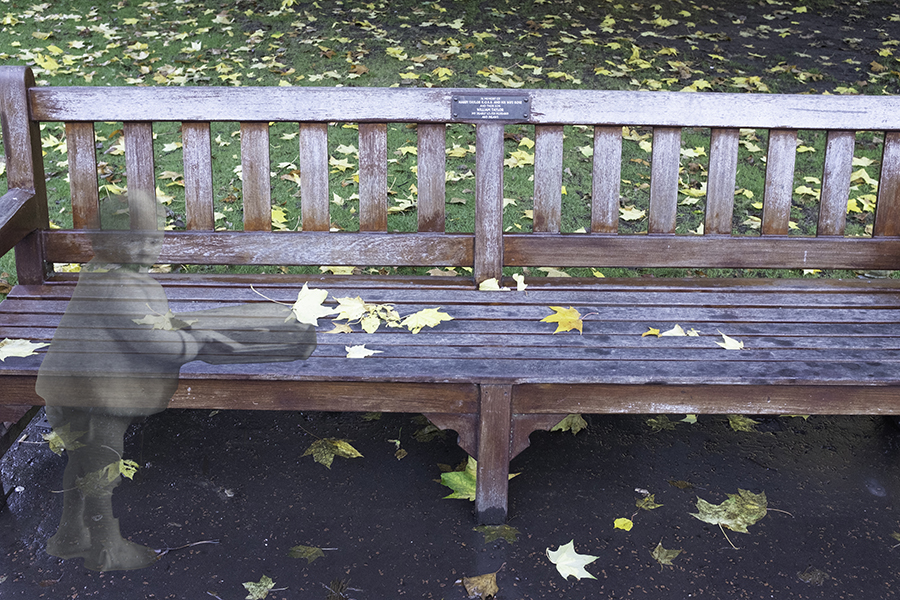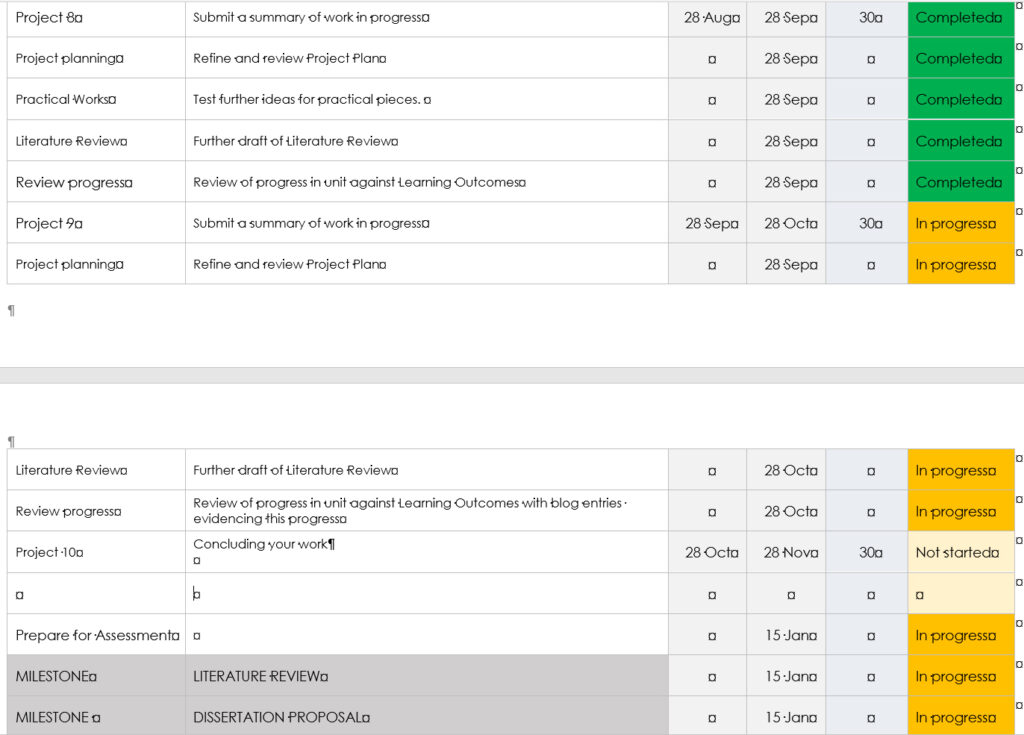Tutor feedback for assignment 8 took the form of a video chat. it is interesting that as I progress through this unit and am now nearing end, that my reflections on feedback are much more involved than they were at the start of this unit.
it feels that my descriptions of these feedback sessions are starting to grow and change from how I used to present them earlier on in this unit.
This month I started by mentioning the emotional and mental impact of my work on myself. I have had to step away from reading certain texts and looking at some works to give myself some time and space and perspective. I always knew that my project based around death, mourning, loss and the death of my daughter would take a toll and the past month have been feeling the negative impact of this. Working on such an intimate and personal project was always going to be challenging for me. I feel that the same part of me which asked internal questions about myself and how I could have been a different father after my daughter died have resurfaced here as I been working on this project with me questioning the value of my work and of my own worth. I explained to my tutor that these feelings stemmed from revisiting that period of my life and of the emotions resurfacing and finding an outlet inside me. I mentioned this as inside I felt very much out of sorts with a different sense of perception, insecure and almost jittery with a jagged torn edge if that makes sense, although I not sure if these impacts are completely within myself and are invisible on the outside. I know these feelings will pass through time. I do not know as I continue to work on my project how often such feelings might come back.
Those negative feelings and thoughts aside, this month I have been working on production of some creative pieces based on earlier trial works. I also produced another draft of my literature review.
My tutor chatted over the emotional impact of my work and, I think sensibly, pointed out that when working in such a field that a lack of emotional response would have been odd and my response should be seen as normal. I asked about maybe recording my thoughts and suggestion made that perhaps this could form a small part of reflective presentation to introduce my work. I will think about this but in meantime have written a broad outline of these feelings in this document.
We spent a little time speaking about potential for further derivations of my test pieces such as exploring colour or monochrome. Also spoke about the reflective presentation as we had worked in a group session on this very topic the day before.
Next, we chatted about my creative enterprises this month which focussed on one strand of some previous test pieces where I used photographs of memorial benches along with found family photographs. My idea attempts to bring out a sense of the memory of people who have died and ask my audience, whoever they might be, to confront their own deaths. I try to explore a sense of a link to a past starting with the bench with the very brief words engraved on the plaque to my reinvention of the stories of people I use shown in found family photographs where I know no stories behind the people in these images. I will deal with my tutor’s responses in no specific order to how we talked these through.
One interesting idea was that the surface of my photograph communicated the idea of barriers and changes in time and space. An example would be that in one image I photographed a bench with someone sat on it and a child playing next to the bench next to autumn leaves symbolising the change in the seasons and death. I mixed this photograph with an image from a photo album shown as a transparent layer. The image contains a path on which the bench sits, the foreground strewn with autumn leaves and on other side of path is a tidy, neatly manicured patch of grass. My tutor’s comment that the path in a way signified the movement from life to death as if it were the River Styx and was interesting that I had placed the transparent group facing the ‘real, live’ figure on the bench. It is interesting to consider the different physical elements of my image when I construct my images and also interesting to consider much wider interpretations such as the end of life and the memory of those who are dead. Very helpful to get such feedback as I hadn’t thought of my image in this way.
As part of my process this month I told about my creatives journey of how and why I was rejecting certain attempts and why I felt these didn’t work. This was a way of explaining why I had made certain choices and why I had presented the images I had. I must keep this in mind as end result isn’t always a polished, glossy piece which pops into existence fully formed but is a process of trial and error and of making mistakes and trying to understand, aided by my research, why some of my ideas seem to work better than others. Interesting that, as this unit has progressed, what I previously would have considered just a creative decision based on my personal likes and dislikes seems far more involved.
Another piece which seemed to attract very positive feedback was my use of the image of a young child. I show this image below just so that this description is more cohesive. I cut the image of the child with a book from its background and placed this as a transparent image on top of my photograph of a bench, carefully positioning the child so its feet appeared to be on the ground and I not get feeling it floating in mid-air. I placed the child’s book on the bench. My tutor said there a certain feeling about this image, something almost haunting about child turning to face the viewer. In another sense if the child looking back at the living from the past or from death and the memory of life? I had a few questions on this work; was my scaling of the child against the bench correct and my framing of child at one end of bench and whether image too simplistic. Some of my other images I rejected as being too busy with too much going on and I wondered if I had gone too far in other direction with this attempt. The feelings behind my choice of this image is the kind of idea which I found difficult at times this month because of mental side but feedback was very positive which was good to hear and was encouraging.

Memorial Bench with Child and Book
We went onto chat about the use of a shot constructed using a museum as the memory vehicle rather than a memorial bench. This seemed to work but maybe needed a description to explain this connection. As with another image where I mixed ‘live people’ with the transparent image from the past, I wondered at the added depth to the meanings of such images for example in this shot with the couple with their shoes off. Is this too much unrelated detail or a good mix between the normal things people do in life set against the memory and more formal nature of my image choice from the past?
Moving away from my practical works to my latest draft of my literature review. Here once again feedback was positive and it seemed my interest in my chosen topic came across as tutor expressed idea that my work was interesting to her which I think must be good as wouldn’t be best idea to bore my tutor with assessment not too far away. My written work a little bulky but I explained my usual way of producing written work was to get down my ideas and then to trim it back. Suggestions to make some changes to the structure of my essay so that I deal with each source in blocks or sections, one for Bathes, one for Sontag and so on and to place my own opinions in a separate section, maybe as part of conclusion. I could then look to my dissertation proposal which forms part of the literature review. I did work on early attempt at my proposal so will be interesting how and where I place this with rest of literature review.
Feedback based on Learning Outcomes
I dialled into a recording of workshop on learning outcomes that took place when I was on holiday. Based on this I have updated my personal update on where I think I have made progress against my learning outcomes.
My own feedback as regards how I think I have progressed and the unit learning outcomes is a little lengthy for this document so I have left this in my blog.
It can be found here-
https://richarddalgleish.net/2022/09/27/progress-review-8-against-learning-outcomes/
I not yet added specific examples from my research and what I have recorded in my blog to my update on my progress of the learning outcomes so will do that for my next review meeting.
Action points
Produce this summary of feedback meeting.
Produce a further draft of my literature review including my dissertation proposal.
Add specific examples from my learning blog into my next review of learning outcomes.
In addition to continued work on:
Review of my project plan.
Student meetings
And at same time, trying to take time, to aid my mental health.



